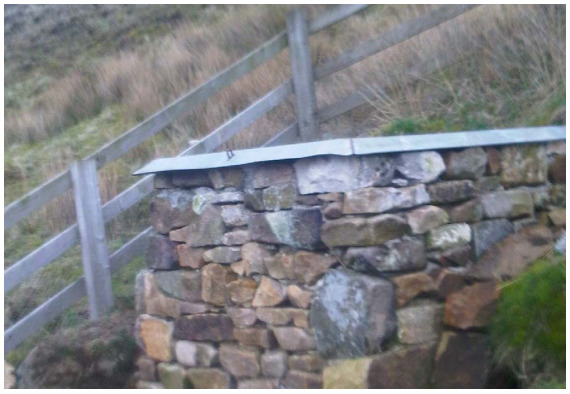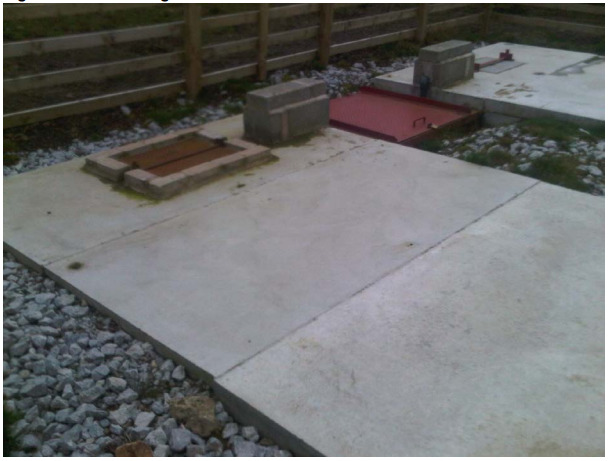Improving the safety and sustainability of a failing rural community water supply in a cost effective manner
This case study relates to a Regulation 9 spring supply serving a village of 80 consumers, including a public house, offices, shops, holiday accommodation and domestic dwellings. The water supply is operated on behalf of the community by a committee constituted as a limited company, whose directors are local residents. Water charges are based on meters where installed, or otherwise based on rateable value, therefore consumers pay for their water in a similar manner to water rates charged by the public water company and thus provide for both operational and capital maintenance costs.
Figure 12: Spring chamber located on a steep slope, surrounded by fencing (0.5 m from the chamber) and boggy land and swallow holes

The spring is located on moorland above the village. The supply emerges on a steep slope protected by a stone built chamber with a steel cover. The back wall of the chamber is protected from ingress by an impermeable membrane and the spring emerges into a half-round clay channel set into the concrete before entering the chamber itself. The overflow is protected from ingress of vermin by a flap valve. From the spring chamber, water passes through a two inch, alkathene pipe into twin storage tanks and feeds by gravity down the hill where it is subjected to treatment before being distributed around the village.
The water supply had been improved over recent years. In 2005, a treatment plant room was built incorporating a bank of cartridge filters, a new ultraviolet (UV) treatment unit (replacing an existing unit) and chlorination dosing equipment. The UV system was designed as the primary disinfection stage and chlorination was intended to provide a residual throughout the distribution system to maintain water quality in the network. There was not sufficient contact time for disinfection with chlorine. A separate borehole had been constructed to provide a contingency supply in the event of failure of the spring supply. The cartridge filters were intended to address turbidity in the raw spring water, which occurs after heavy rainfall and had the potential to compromise disinfection. A local engineer maintained the treatment facilities, replacing cartridge filters, cleaning and replacing the UV units, and monitoring the chlorine dose. A log book was kept of maintenance tasks and this was used to trigger the ordering of spare parts or other actions.
In 2008, E.coli was detected in a water sample and the directors and local authority undertook a joint inspection of the water holding tanks, whereupon it was found that the concrete had become porous allowing ingress of surface water into the tank. These tanks were replaced the following year (see Figure 13).
Following the introduction of the new private water supply regulations in 2010, a risk assessment was carried out which identified a number of uncontrolled hazards, the most significant being elevated turbidity after heavy rainfall with associated bacteriological failures. There were also issues with the condition and integrity of the water mains. The local authority put in place a Regulation 18 Notice requiring boil water advice to be given to consumers until further investigation and improvement works could be carried out.
Figure 13: New storage tanks

It was apparent to the directors that there was insufficient finance available to make the further improvements required given the expenditure that had already been incurred since 2005. All possible options were explored, including a connection to the public mains supply. Although such a connection was feasible, it first necessitated bringing the village network up to water company standards. Informal discussions with village residents suggested that the costs involved were beyond the means of many and would require all to participate. At this stage, and after discussions with various suppliers and consultants, the directors sought the advice of the Inspectorate on what other support might be available to the village.
After liaising with the local authority, the Inspectorate and the local water company undertook a joint site visit. This revealed that while the spring chamber was protected by a post and rail fence, this was sited very close to the chamber (0.5m). There was evidence of sheep droppings on the slope immediately above, and the boggy ground and swallow holes surrounding the spring chamber indicated a route of ingress to the supply of faecal contamination. Environment Agency vulnerability maps for the area also confirmed that groundwater was highly vulnerable to surface water inflow and therefore potentially at risk of Cryptosporidium. While UV is an effective control measure against Cryptosporidium it is only fully effective when the raw water being treated has a turbidity of less than 1NTU. Overall, the site visit confirmed that a combination of grazing animals and site geology and topography was leading to contamination and turbidity, and the latter was compromising disinfection.
Following the site visit, the committee put together an action plan to address the risk. The steps in the plan were prioritised with each being monitored for effectiveness:
- Stage One: source protection: Involved widening of the protection zone around the spring by installing a new rabbit proof fence at a distance of 4m and installing an impermeable lined diversion ditch along the fence line to divert surface and subsurface flows away from the source during heavy rainfall.
- Stage Two: catchment measures: Involved exclusion of sheep (livestock) from the wider catchment above the spring source by fencing a fan shaped area running 200m upslope and 100m across the top slope with a diversion ditch dug across the top of the fan to prevent faecal matter being washed into the protected area.
- Stage Three: water supply asset improvements: Involved enclosing the relief valve on the storage tanks and raising the covers on the tank roof to give an upstand to prevent ponding of rain and seepage under the cover and joints. Additional works specified were removal of any redundant pipes and installation of a turbidity monitor that would trigger diversion of turbid water to waste and activation of the back up borehole supply. The final step, if needed, related to extending the contact time available for chlorination.
The action plan was submitted to the local authority and incorporated in the Regulation 18 Notice. The work to protect source, catchment and the tanks took place in 2011 and 2012. Planning consent was required from the National Parks Authority to enable improvements to be made to the access track and then for a solar powered monitoring system to be installed. This consent was obtained in 2012 and work on the access track was carried out in the autumn.
Once the power generation and monitoring arrangements have been installed in 2013, a turbidity monitor between the spring and the storage tanks will activate a motorised valve, which will divert the water to waste when turbidity exceeds 1NTU. The borehole will then start up to supply the storage tanks controlled by a ballcock. The borehole is capable of providing sufficient flow to meet demand in the event of loss of the spring supply. To ensure the supply is maintained if the borehole shuts down, a level control monitor will be sited in the tanks to allow spring water to be introduced when the level falls below 25%. Telemetry will alert an engineer by text message if turbidity exceeds 1NTU or if the tank levels fall below 25% full.
This case study illustrates how an upland spring village supply can be protected and improved in a cost effective and sustainable manner when a source to tap risk assessment is carried out with the support of technically competent persons, knowledgeable in how contamination of such sources is likely to arise and how relatively simple steps can be taken to prevent treatment systems from being affected adversely as a consequence. This case also highlights how the collective expertise of the Inspectorate and the local water company can be called upon to provide local authorities and communities facing similar circumstances of a failing village supply with technically appropriate and independent advice based on the multi-barrier water safety plan approach to safeguarding water supplies and public health.
